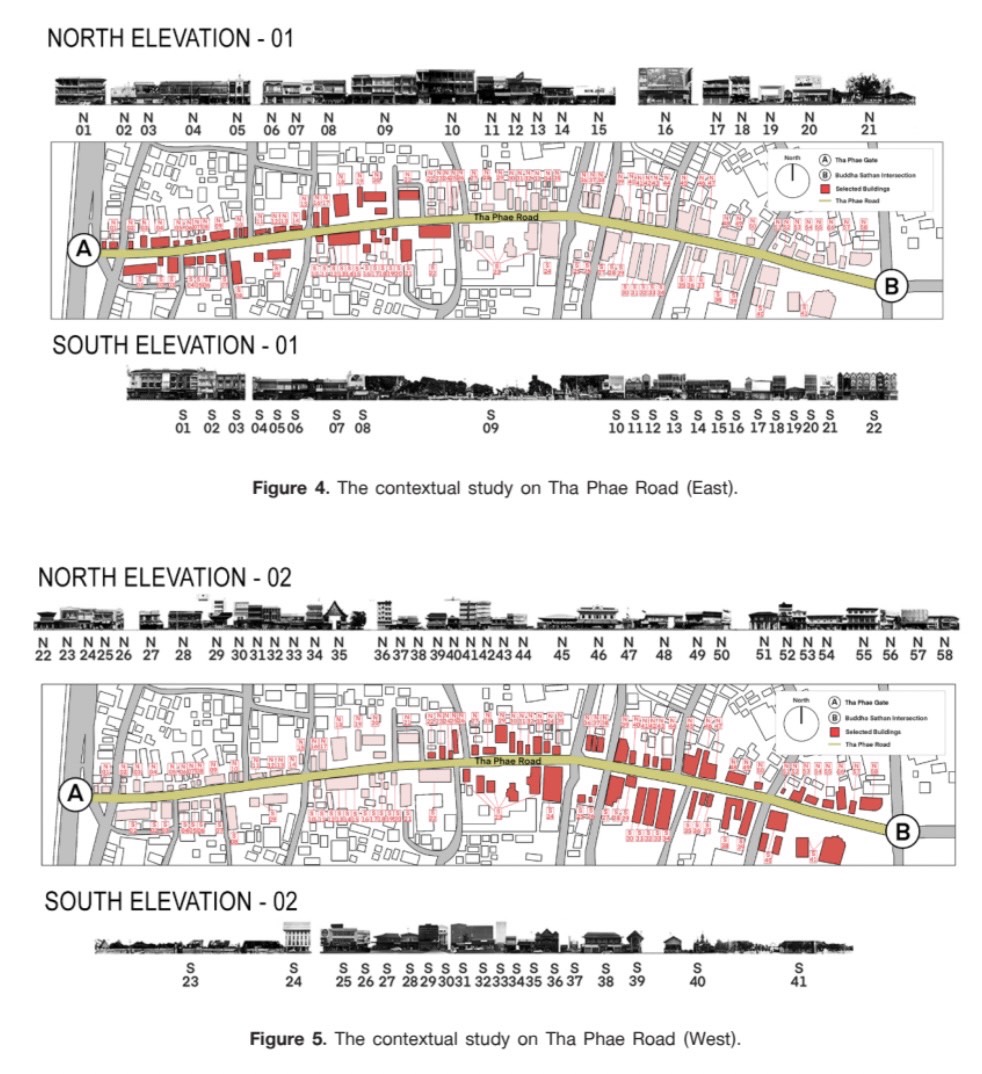From Traditional to Postmodern: Architectural Evolution and Implications for Cultural Preservation on Tha Phae Road, Chiang Mai, Thailand
Main Article Content
Abstract
This study examines the architectural heritage of Tha Phae Road in Chiang Mai, Thailand, which reflects the city’s cultural and economic development. The preservation of its historic character and cultural significance is of utmost importance as rapid urbanization and development threaten its potential loss. Using Grounded Theory, the study analyzes non-numerical data, including photographs and site investigations, to identify the area’s four main architectural styles: Modern, Postmodern, Traditional, and Traditional-Colonial, with Modern being the most prevalent. The Compound Annual Growth Rate (CAGR) is used to examine the distribution of styles over an 11-year period, revealing a decline in Traditional and Modern styles and a positive growth rate of Postmodern architecture. To preserve and enhance the area’s visual quality while allowing for new development, the study proposes a Façade Control Guideline and zoning regulations. These guidelines consider criteria such as the history and importance of Tha Phae Road, ensuring that any changes made to the area respect the overall scale and character of the street. This study’s findings have important implications for the development and preservation of Tha Phae Road’s identity and highlight the value of preserving the cultural heritage and visual quality of the area.
Downloads
Article Details

This work is licensed under a Creative Commons Attribution-NonCommercial-NoDerivatives 4.0 International License.
All material is licensed under the terms of the Creative Commons Attribution 4.0 International (CC-BY-NC-ND 4.0) License, unless otherwise stated. As such, authors are free to share, copy, and redistribute the material in any medium or format. The authors must give appropriate credit, provide a link to the license, and indicate if changes were made. The authors may do so in any reasonable manner, but not in any way that suggests the licensor endorses you or your use. The authors may not use the material for commercial purposes. If the authors remix, transform, or build upon the material, they may not distribute the modified material, unless permission is obtained from JARS. Final, accepted versions of the paper may be posted on third party repositories, provided appropriate acknowledgement to the original source is clearly noted.
References
Askari, A., Dola, K., & Soltani, S. (2014). An evaluation of the elements and characteristics of historical building façades in the context of Malaysia. Urban Design International, 19, 113-124. https://doi.org/10.1057/UDI.2013.18 DOI: https://doi.org/10.1057/udi.2013.18
Auttarat, S., & Poonsukcharoen, N. (2022). Readiness factors of Chiang Mai city to support sustainable and livable city long-stay tourism. Journal of Architectural/planning Research and Studies (JARS), 20(1), 1– 20. https://doi.org/10.56261/jars.v20i1.247622 DOI: https://doi.org/10.56261/jars.v20i1.247622
Bryant, A., & Charmaz, K. (2007). The SAGE handbook of grounded theory. SAGE. DOI: https://doi.org/10.4135/9781848607941
Carbone, F. (2016). An insight into cultural heritage management of tourism destinations. European Journal of Tourism Research,14, 75-91. https://doi.org/10.54055/ejtr.v14i.244 DOI: https://doi.org/10.54055/ejtr.v14i.244
Chantavilasvong, S. (1978). Khwāmkhaočhai bāng prakān čhāk kānsưksā sathāpattayakam hō̜ngthǣo. [A study of some aspects of shophouse architecture]. [Unpublished master’s Thesis].Chulalongkorn University.
Chiang Mai City Municipality. (2020). Thētsabanyat nakhō̜n Chīang Mai. [Chiang Mai municipal law]. Retrieved December 17, 2022, from http://www.cmcity.go.th
Choomsang, T. (2011). 2011Design guidelines for Jaroen Rat Road, Watkate, Chiang Mai, Thailand. Retrieved October 24, 2022, from https://pubhtml5.com/hzao/gycy/basic/
Darwish, M. (2016). Problematic of preserving the architectural heritage and its sustainability (Sheikh Sa’eed House in Dubai for example). International Journal of Innovation and Scientific Research, 27, 354-364.
Google. (n.d.). Google maps. Retrieved August 25, 2022, from https://www.google.co.th/maps/@18.7880249,98.99996412,1570m/data=!3m1!1e3?hl=en&entry=ttu
Glaser, B., & Strauss, A. (1967). The discovery of grounded theory: Strategies for qualitative research. Sociology Press. DOI: https://doi.org/10.1097/00006199-196807000-00014
Horayangkura, V., Intraravichit, K., Inpuntung, V., & Chantavilasvong, S. (1993). The development of concepts and design in architecture: Past, present and future. Amarin Printing Group.
Khatami, S. M., & Boujari, P. (2022). Analyzing the heritage of Tehran’s urban façades in the recent century. City, Territory and Architecture, 9(1),19. DOI: https://doi.org/10.1186/s40410-022-00166-1
Li, T. L. (2007). A study of ethnic influence on the façades of Colonial shophouses in Singapore: A case study of Telok Ayer in Chinatown. Journal of Asian Architecture and Building Engineering, 6(1), 41–48. DOI: https://doi.org/10.3130/jaabe.6.41
Lieorungruang, V. (2008). Lanna architectural conservation: Guidelines for historic buildings in Northern Thailand [Unpublished doctoral dissertation]. Silpakorn University.
Loakaewnoo, T. (2023). The composition and value of architectural heritages in Pattani old town. Journal of Architectural/Planning Research and Studies (JARS), 21, 35-48. https://doi.org/10.56261/jars.v21.255557 DOI: https://doi.org/10.56261/jars.v21.255557
Pattananurot, P., & Khongsaktrakun, S. (2022). Conservation of row houses in old commercial district Mekong Riverside Nakhon Phanom Province, Thailand. Journal of Urban Culture Research, 25, 114-134.
Pisuttakoon, N. (2011). Kānraprū ʻongprakō̜p thāng čhintaphāp khō̜ng nakthō̜ngthīeo chāo Thai bō̜riwēn yān thanon thā phǣ čhangwat Chīang Mai. [Perception of Thai tourist through physical elements: Case study Thapae Road, Chiang Mai]. [Unpublished master’s thesis]. Silpakorn University.
Sanyakiatikun, S. (2002). Nǣothāng kān khūapkhum dān kāiyaphāp nai khēt phư̄nthī ʻanurak mư̄ang kao Chīang Mai. [Guidelines for physical control in the conservation areas of Chiang Mai old city]. [Unpublished master’s thesis]. Chulalongkorn University.
Satrabhaya, B. (1979). Pictures of Lanna in the past. Retrieved October 18, 2022, from http://library.cmu.ac.th/ntic/picturelanna/search_form.php
Sommer, B., & Sommer, R. (1991). A practical guide to behavioral research: Tools and techniques (3rd ed.). Oxford University Press.
SuchaXaya, C. (1981). Tưkthǣo kap kānʻō̜kbǣp chumchon. [Shop house and urban design 1981]. [Unpublished master’s thesis]. Silpakorn University.
Suwatcharapinun, S. (2016). Yō̜ ʻon ʻān sathāpattayakam tưkthǣo nai thanon thā phǣ : sēnthāng khō̜ng khwām thansamai mư̄ang Chīang Mai. [Re-reading architecture of row-houses in Thapae Road: A passage of Chiang Mai’s modernization]. NAJUA: The History of Architecture and Thai Architecture, 13, 230-259.
UNESCO. (2012). Records of the general conference, 36th session, Paris, 25 October - 10 November 2011, v. 1: Resolutions. (pp. 51-54). UNESCO.
Wall Street Prep. (2023). Growth rate. Retrieved April 27, 2023, from https://www.wallstreetprep.com/knowledge/growth-rate/
Wandeler, K., & Lo, A. (2024). Exploring systems thinking and systemic design: Insights from a summer school experiment addressing urban health crises. Journal of Architectural/Planning Research and Studies (JARS), 22. https://doi.org/10.56261/jars.v22.267810 DOI: https://doi.org/10.56261/jars.v22.267810


